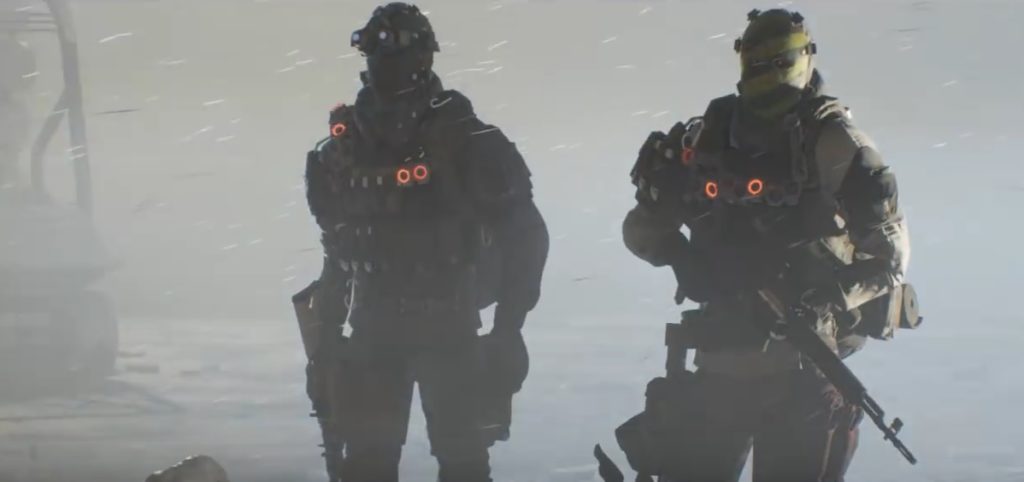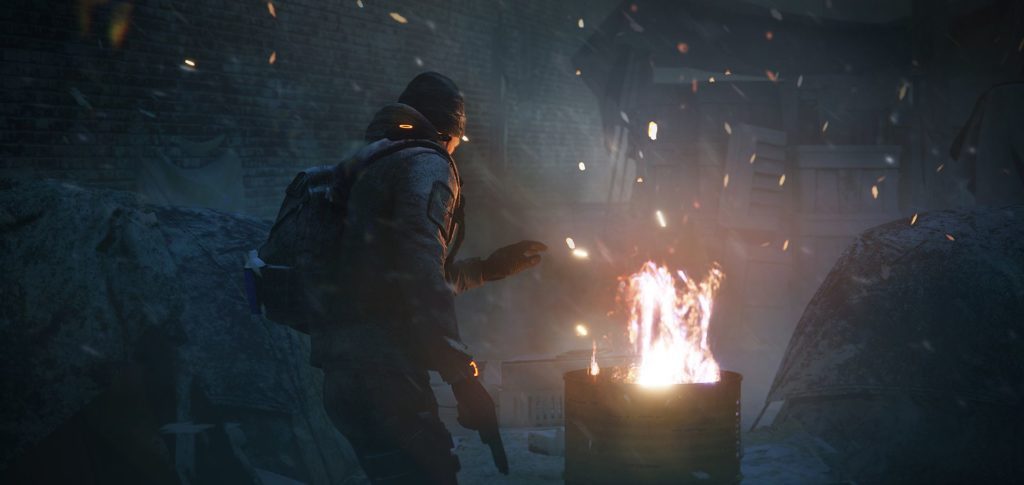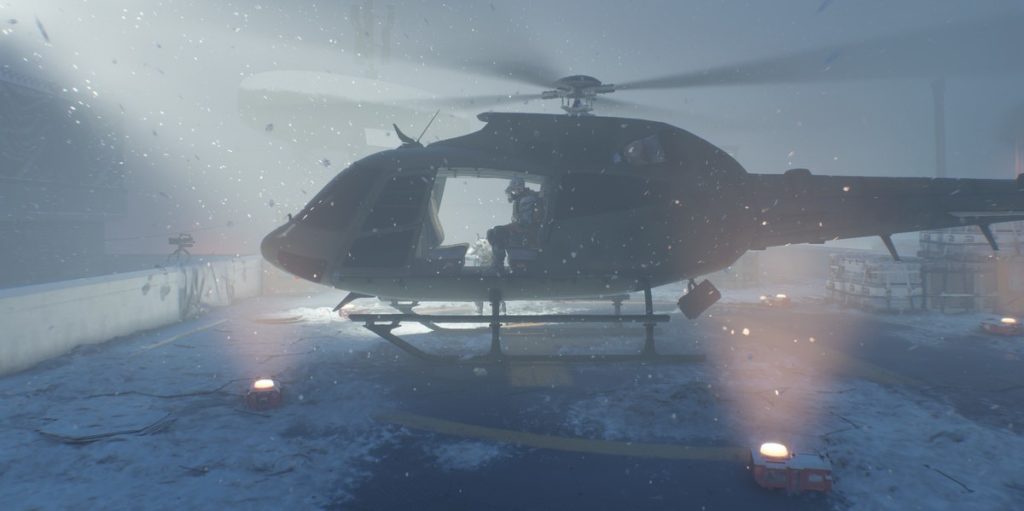Familiar are the landmarks and monuments slowly succumbing to the uninterrupted snowfall. And familiar still are the clutches of gun-toting wardens that have displaced the streets with their hastily formed borders. For the first time in two years, I am playing Tom Clancy’s The Division – a game that I originally parted with in spite of a growing fondness for the havoc and scarification of a new age Manhattan. But it wasn’t gradual apprehension for the post-pandemic city that ebbed away at my enjoyment of The Division, rather the rigid bottleneck that defined its endgame.
Before ever reaching a point of unavoidable saturation, The Division laid forth a world dormant in a state of purgatory, asking of its agents to help commence a rebuilding process in the wake of disaster. What followed was the broadening of a serviceable plot that freely encouraged discovery: of the collapse, its affected, and its degradation of the city. The distribution of the virus had been sufficiently outlined, before its fate became dependant on the will of an agent looking to incite a rebellion from beneath the city’s ashes. And teetering upon this precipice is where the story of The Division wound to a close, the narrative now succeeded by a ride upon the carousel of gear chasing and minor stat increases.
It was easy to hit the wall, what with the state of the game back then offering little in the way of longevity. By the time that every side mission had been completed, every collectable acquired and every wandering world-boss felled for the thousandth time over, all that remained of The Division was to assemble complete sets of character-defining gear while only being drip-fed the means to do so. I stuck around long enough for the first of the game’s paid expansions, ‘Underground’, to drop. A procedurally generated dungeon crawl fit the bill for a sizeable slab of content built for the purpose of a dynamic experience. The caveat with the Underground was that, in only a short space of time, pathways would become recognisable, objectives easy to anticipate. Underground was the same dreariness that we had become used to, just scaled back a little. It was predictable. And the predictability of it all was the most potent poison infecting the Division’s endgame.
Returning to The Division after such a long time was a little bit overwhelming. Every few steps, an informative placard rooted me to the spot in order to explain the many facets of a new piece of content introduced in my absence. Pings lit up the world map, each a new endeavour clamouring for my attention. And in The Terminal, the last place I visited those few years ago, the entrance to the Underground was now flanked by zones for PvP combat, Global Events and something called Survival. It was with little hesitation that I ventured forth, entirely unprepared for the dangers that existed beyond those iron-white doors. And though my first foray was marked by a lack of understanding, the tension that Survival thrives upon would remain a constant in every successive attempt.
In Survival, your agent boards a helicopter and heads to the Dark Zone in order to retrieve stolen antivirals at the height of a ferocious blizzard. With a certain inevitability, your chopper goes down in the storm, rendering you unconscious. As you awake, you have no equipment, no resources and a steadily progressing sepsis gnawing at your immune system from a puncture wound that you sustained during the crash. Your objective in Survival – other than merely surviving – is to complete the parameters of the mission: craft a filtration mask in order to enter the Dark Zone, retrieve the antivirals, and then craft a flare gun in order to summon an extraction. And eating away at your resolve throughout all of that are not only the typically perilous foot-soldiers roaming the streets, but also the steady progression of your illness and the biting touch of the cold.
Survival is the antithesis of The Division’s cyclical loot marathon; it’s slow, it’s punishing and it’s rewarding in spite of any gear drops that it may offer. Completing a Survival session takes patience, and between the aggressive sprints through certain story missions or Incursions in which efficiency of time spent is the focal point, Survival throws it all out of the window in favour of a more temperate, yet mentally taxing ordeal. If anything, Survival does need to offer more avenues for accruing gear, which is why many players within the Division community don’t see it as a viable choice to spend their time. You’re not at the mercy of loot drops in Survival, just the jagged edges of the world around you – a foreign concept, given the game’s emphasis on painstakingly increasing the three-digit gear score number that infers your approximate strength.
Just as you become more knowledgeable of enemy patterns in Resistance or the mechanics on display in certain Incursions, so does Survival require a knowledge of every single part that comprises its whole. To keep the cold at bay, you’ll need insulating clothing, which is crafted by way of scavenging pieces of fabric found tucked away in every nook and hovel. Similarly, tools and electronics return skills to your repertoire, while weapon parts are used in conjunction with other materials to create stronger armaments. Gradually creeping thirst and hunger is kept at bay with canned food, energy bars, water and soda, while the threat of succumbing to your infection is allayed by finding painkillers and medicine that halt the countdown to your demise. And with the tick of the clock lingering in your periphery, success can be largely built on recognising landmarks through the mist, and knowing whether or not to spend your most precious commodity searching the area.
At least initially, you’re never alone in Survival. Up to twenty other agents may have boarded twenty other helicopters that met twenty identical grisly ends. And just like you, they’re all out to keep themselves alive above all else. I recall agents galloping past me into the white haze from the interior of a building I had just encountered, the entire complex already turned over and emptied. But as another Survival run threatened to end in defeat, an agent from out of the blue expended a precious med-kit on bringing me back from the brink, ensuring I made it to the extraction alive. I got out. He didn’t.
The unpredictable nature of other players is just part of the appeal, for we’re all slaves to the same pervading anxiety that reminds us that death and the loss of all progress may be only a single gunfight away. Every agent begins a Survival session with the same generic common gear, the same low calibre pistol. Until you stumble across a rifle with a bit of kick behind it and a chest piece capable of stopping bullets rather than inhaling them, even the most routine of engagements could be your last. And that’s if the cold doesn’t catch you out while you huddle for cover from the barrage of gunfire heading your way. Thankfully, you have the luxury of being able to pick your battles, though only up until you’re ready to hail an extraction. After you do, every hoarded material, objective completed and winter coat scavenged may not be enough to fend off the Hunter headed your way.
As the droning ambient soundtrack continues to pull at the nerves, it’s occasionally interrupted by the distortion of your HUD and the off-putting buzz of electronic interference. Ever since you vaulted the barricade into the Dark Zone, you have been tracked. And as your flare pierces the night sky, so too will your pursuer finally pounce. Hunter’s are the Division’s boogeymen – elite soldiers that move quicker, hit harder and have access to the same plethora of skills and abilities that you do. To commence an extraction is to test the mettle of your survivability in the harshest of ways. And for each agent present as the chopper hones in on your location, another Hunter emerges from the shadows. The telltale sign of a failed extraction is the flooding of the kill-feed and the plastering of that foreboding message across your screen – “An agent has left survival, 9 agents remaining.” Better wait for the next one, then.
Substantial is both the level of challenge and the individuality of Survival as a standalone experience. Watching as the helicopter blades spin up and lift you out of the Dark Zone is as relieving as it is satisfying. And as you reenter the Terminal following a tallying up of your score, it’s easy to immediately think back on the last hour-or-so spent in joyous discomfort. Though there’s no shedding the image of being a broken spoke on the wheel. Survival is just too much risk, with too little reward – a damning impediment when gear is of greater value than any currency. But if Survival falters in its cohesiveness, it succeeds in its role as an extension of a Manhattan reborn in chaos.
Wandering the streets alone, you begin to pay a little more attention to the corpses of the Joint Task Force adorning lampposts and wallowing in gutters. You notice the blood lining the brickwork and the piles of bodybags reaching for the clouds. In audio logs, the horrors of New York’s decimation are laid out plainly. In journal entries, it’s the speed of it all that gets you. Though Survival doesn’t even manage to tack a footnote on the Division’s core narrative, it does offer an extension into the world that you inhabit long after the virus has dissipated. It’s in the relentless cold and the sharp tinge of desperation – it’s isolation. The island of Manhattan is isolated, cut-off from the rest of the world. And without your skills, your armour, or your trusted rifle, for the first time, you begin to feel vulnerable. Survival is an exercise in hopelessness, built as a window into a reality that the core game may only elaborate on indirectly. It’s the subtle snowfall and the aching quiet that defines Survival – the reality of joining the rest of the city’s lost and forgotten.


